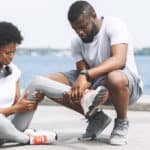You might be aware of the importance of having an adequately equipped first aid kit on hand to deal with medical emergencies in the home and at work, but do you know what a first aid kit should contain to handle an emergency you may have with a pet.
The guide dog leading its trusted owner is an expensive asset, the family dog or cat is a trusted companion. Just like you, animals living in your home can be the victims of accidents too. Are you equipped to deal with a broken leg if your dog is hit by a car, or hurt in a fight or steps on glass during a walk?
Remember, a first aid kit equipped to deal with a pet emergency should contain medical supplies and equipment that allows you to provide first aid to an animal in distress, quickly and effectively, before seeking qualified veterinarian assistance.
Basic contents for an animal first aid kit |
|||
| Amount | Supply | ||
| 2 | Paw tip bandage (knuckle) | ||
| 2 | Fingertip bandage | ||
| 1 | Tape roll, such as Micropore ® | ||
| 1 | Trauma pad, 50mm x 100mm (absorbent dressing that helps stop bleeding) | ||
| 4 | Sterile gauze sized 100mm x 100mm | ||
| 4 | Gauze sized 50mm x 50mm | ||
| 1 | Gauze roll 50mm | ||
| 2 | Examination gloves | ||
| 1 | Instant cold pack | ||
| 1 | Forceps to remove splinters | ||
| 2 | Antibiotic ointment such as Betadine ® | ||
| 10 | Alcohol pads such as Webcol ® | ||
| 10 | Antiseptic towelettes containing Benzalkonium Chloride instead of alcohol | ||
| 1 | A suitable sized impermeable bag for the safe disposal of biohazardous waste such as blood | ||
| 1 | Pet first aid guide | ||
| 4 | Leg splints/tongue depressors | ||
| 10 | Cotton wool buds | ||
| 1 | Elastic bandages (50mm) | ||
| 2 | Splinter removers (lancets) | ||
| 3 | Sting relief pads containing a local anaesthetic | ||
Having a first aid kit on hand can help you to provide essential care immediately, before critical care becomes available.
Remember to keep your pet first aid kit somewhere easily accessible and check your first aid kit regularly so you can improve on and replace any items that have been used.
Useful tips:
- If your first aid kit is going with you on a hike or any other outdoor activity, make sure it’s waterproof.
- Check the container in which your first aid kit is kept regularly to make sure it is not damaged.
- Check the medical supplies and equipment for any expired items and remove these and replace them with fresh supplies immediately.
- Keep a list of the contents of your first aid kit on the inside of the container. This will serve as a quick and useful checklist to make sure that all the required items are always available.
Sources:












